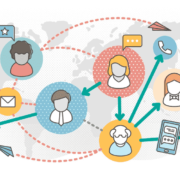3 Reasons You’re Losing Senior Living Leads
Did you know you could be losing senior living leads—and you might not even be aware it’s happening? If the sales team is hitting its numbers, you might think everything is operating like a well-oiled machine. And yet your community could be losing out on GREAT senior living leads due to three big culprits: Your website, your conversion points, and your front desk.
Here’s what you need to know.
You might be losing senior living leads if your website is slow, outdated, or both
When was the last time you refreshed your site? Three years ago? Five? Can’t remember? Prospects don’t necessarily need a fancy-schmancy website with tons of bells and whistles. But they do want a modern website that’s easy to navigate, has current information, and renders fast across mobile devices.
If your website is outdated, good prospects might think (even subliminally) that this outdated feel will extend to your community. And people have zero patience for slow sites. Remember, to a new prospect, senior living communities essentially sell the same thing. So if your site doesn’t load quickly, the visitor won’t think twice about finding one that does.
What to do, how to fix:
- Check the bounce rate for critical pages. If people enter the site but quickly leave, something is amiss. Marketing guru Neil Patel explains how to check bounce rate in Google Analytics 4.
- Review content. Is any of your content obsolete or incorrect? For example, did you recently revamp your community’s foyer, but pictures of the “old” foyer remain on the site? The old pictures aren’t telling the true story. Not to mention, for folks who DO visit, it will be quite a disconnect from what they were expecting. Even small things, like a copyright notice in the footer that says “2019,” can affect trust.
- Use Google’s PageSpeed Insights (PSI) to evaluate your site. As its name suggests, PageSpeed Insights will analyze how fast your site performs across desktops and mobile devices and suggest improvements. That’s the simple definition. Check out this article from Semrush for a deeper dive into how PSI works.
- Have an objective third-party audit your site. Getting an independent audit, like our Total Online Presence Audit, is an excellent way to know if your site is helping to attract and convert leads.
You might be losing senior living leads if you haven’t thought through your conversion points
Debbie Howard, CEO of Senior Living SMART, was telling us about an experience she recently had on a prospect’s website. “I clicked on ‘Schedule a Tour’ and was redirected to a multi-page survey with a million questions. I thought, what? No. If I want to schedule a tour, I want to pick a date and time to schedule it. Don’t say I can schedule a tour and then bring me to a survey.”
This isn’t an isolated experience, either. Sadly, we see too many convoluted conversion points on senior living community websites. You must be thoughtful in how and where you ask people to act—and what that action is.
What to do, how to fix:
- Simplify the conversion process. Ensure that actions like scheduling a tour are straightforward and require minimal steps.
- Audit conversion paths. Regularly check all the conversion paths on your website. Ensure links and forms work correctly and the user is directed to the appropriate confirmation page or next step.
- Test different approaches. Experiment with different types of conversion points, such as buttons, forms, or chatbots. Use A/B testing to determine which methods are most effective in engaging prospects.
- Monitor conversion rates. A low conversion rate could indicate a problem with the design or functionality of that particular conversion point.
- Regularly audit your calls-to-action (CTAs). CTAs must be clear and compelling and communicate precisely what will happen when a user clicks. Avoid misleading CTAs that don’t deliver on their promise.
- Optimize for mobile devices. Many users will access your site via mobile devices. Ensure your conversion points are easy to use on smartphones and tablets, with responsive design and touch-friendly interfaces.
- Offer multiple ways to connect. Some prospects might prefer different contact methods like phone calls over emails or texts. Provide various options to cater to different preferences.
- Analyze user behavior. Use tools like Google Analytics to understand how users interact with your conversion points. Look for patterns like where they drop off or what actions they take before converting.
You might be losing senior living leads due to your front desk
In addition to solid conversion points, you must also ensure you’re scoring website leads correctly so that sales-ready leads receive speedy follow-up and marketing-qualified leads enter nurturing workflows. The communities that consistently win are the ones who follow up on sales-ready leads the fastest.
But here’s the thing that many communities overlook. What happens when a sales-ready lead picks up the phone and calls your community’s main number? Your front desk person is likely warm and friendly, but they are not sales-oriented. They don’t have a sales mentality. They’re also juggling plenty of non-sales calls (e.g., family members trying to reach a resident or a nurse). Sales calls don’t receive priority or any sort of white-glove treatment. The front desk person might place the prospect on hold, dump them into voicemail, or give incorrect or incomplete info.
What to do, how to fix:
We don’t have a bulleted list of suggestions, like training your front desk staff better.
Sure, you could train your front desk team to recognize sales inquiries from general inquiries. But what happens when they transfer the sales inquiries to a salesperson within the community? Unless the sales rep is sitting at their desk and they’re available to answer the call, the prospect will likely go to voicemail.
This is an ongoing problem plaguing senior living communities. Sales reps are busy giving tours, networking, and working closely with prospects preparing to sign a lease. They’re not sitting idly by their phones. Not to mention, sales reps don’t work 24/7.
Recognizing this, our team created a true senior living lead management solution. It’s called LeadGenie. LeadGenie offers virtual sales support to ensure every prospect is responded to, increasing conversions to tours and move-ins. Learn more about LeadGenie here.
Stop losing valuable senior living leads
If you have questions or need help with any of the above, get in touch. We’re passionate about helping our clients attract the right prospects and close more of them. Let’s talk soon.









